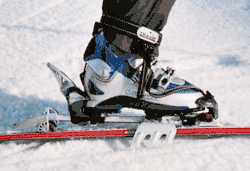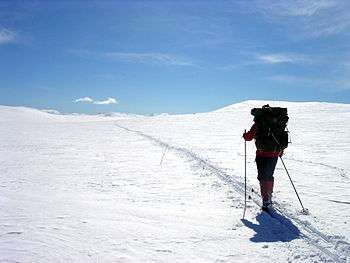Ski touring

Ski touring is skiing in the backcountry on unmarked or unpatrolled areas. It is similar to backcountry skiing. Typically touring is done off-piste and outside of ski resorts, and may extend over a period of more than one day.
Ski touring cuts across either Nordic and Alpine forms and embraces such sub-disciplines as Telemark and randonnée. A defining characteristic is the skier's heel being free to allow a natural gliding motion while traversing and ascending terrain which may range from perfectly flat to extremely steep.
Ski touring has been adopted by skiers seeking new snow, by alpinists, and by those wishing to avoid the high costs of traditional alpine skiing at resorts.[1] Touring requires independent navigation skills and may involve route finding through potential avalanche terrain.
Ski touring has parallels with hiking and wilderness backpacking. Ski mountaineering is a form of ski touring which variously combines the sports of Telemark, Alpine, and backcountry skiing with that of mountaineering.
History
The history of ski touring is unwritten. Among the sport's pioneers are:
- John "Snowshoe" Thompson, perhaps the earliest modern ski mountaineer, a prolific traveler who used skis to deliver the mail at least twice a month up and over the steep eastern scarp of the Sierra Nevada to remote California mining camps and settlements. His deliveries began in 1855 and continued for at least 20 years. Thompson's route of 90 miles (140 km) took 3 days in and 48 hours back out with a pack that eventually exceeded 100 pounds of mail.
- Cecil Slingsby, one of the earliest European practitioners, who crossed the 1,550 m (5,090 ft) high Keiser Pass, Norway, on skis in 1880.
- Adolfo Kind
- Arnold Lunn
- Ottorino Mezzalama
- Patrick Vallençant
- Kilian Jornet Burgada
Terminology
Ski Touring involves both uphill and downhill travel without needing to remove skis.[2] Terms exist according to how the terrain is accessed, and how close it is to services:
- Frontcountry: off-trail within ski area boundaries where ski lifts and emergency services are close at hand.
- Slackcountry: terrain outside of the ski area boundary that is accessed from a lift without having to use skins or bootpack. Usually this also includes area with access back to the lift as well. For purists, this could also include where people use a car as a shuttle.
- Sidecountry: terrain outside marked ski area boundaries yet accessible via ski lift. Typically sidecountry requires the skier to hike, skin, or climb within ski area boundaries to reach or return from the sidecountry area, or both.
- Backcountry: skiing in remote areas not within ski area boundaries.
Technique
Ski touring requires the ability to ski off-piste, good navigation skills, and good awareness of the risks of the mountain environment in winter. In particular it requires the knowledge to assess and test snow conditions to minimise the risk of avalanche.
Descending is exactly like alpine skiing: sliding down the hill on skis. When the ski tourer is ready to go uphill, climbing aids are used to prevent slipping backward.
As the slope angles increase, the climbing ski-tourer will make switchbacks, using kick turns to change direction, typically resulting in a line that climbs at a moderate angle of 20-30 degrees. Skin tracks can be seen as zig-zags heading up a snowy mountain. Ski-tourers try to maintain the up-tracks in avalanche-safe zones as they head up the mountain, staying out from under dangerous cornices or slide paths. Setting a proper and safe skin track requires a great deal of skill and avalanche knowledge as the tourer spends most of their time climbing. Traveling quickly up potential avalanche terrain is important for safety as well. Thus physical fitness is a crucial element of safe mountain travel.
Equipment

Styles of equipment
Alpine skiing equipment can be used for ski touring with the addition of a removable binding insert that allows for free heel swing on ascents. Nordic ski touring is skiing with bindings that leave the heels free all the time. Thus, Nordic skiers do not have to change back and forth between uphill and downhill modes, which can be advantageous in rolling terrain. At the lighter, simpler end of the scale, Nordic skis may be narrow and edgeless cross-country types for groomed trails or ideal snow conditions, used with boots that resemble soft shoes or low boots. Backcountry Nordic uses a heavier setup than a traditional Nordic setup, but not as big and heavy as a full Telemark setup. Telemark is at the heavier end of the Nordic skiing equipment spectrum, for steep backcountry terrain or ski-area use. Alpine Touring (AT) or randonnée equipment is specifically designed for ski touring in steep terrain; a special alpine touring binding, otherwise very similar to a downhill binding, allows the heel to be raised for ease in ascending but locked down for full support when skiing downhill
Ascending aids
Various devices can be used to make ascending easier. "Fish scale" pattern friction aids embossed in the center section of the bottom of skis, or sticky ski wax in this center pocket are used in lower angle or rolling terrain. Climbing skins are used when fish scales or ski wax fail to provide sufficient grip for skiing steeply uphill. Ski crampons (also called Harscheisen (German), couteau (French), or rampant (Italian) may be attached when conditions are particularly icy or the grade too steep for skins.
Ski Touring Regions


Ski touring can take place anywhere that has suitable snow and terrain, and reasonable means of access to the trailhead, i.e. plowed road, snowcat or aircraft. Some examples include
Iceland
Activities center on the Troll Peninsula in northern Iceland.[3]
Norway
Touring in Norway has a long tradition. Skiing was originally a practical means of winter transportation. Ski touring formed the basis of the polar expeditions of Norwegian explorers like Fridtjof Nansen and Roald Amundsen. There are thousands of kilometers of marked ski routes, either in the forested areas and the mountain areas above the tree-line. The trails are maintained by organizations like Skiforeningen in the Oslomarka area and Norwegian Trekking Association nationally including Hardangervidda, Rondane and Jotunheimen. The Norwegian Trekking Association (Norwegian: Den norske turistforening, DNT) maintains mountain trails and cabins in Norway. The association was founded in 1868. DNT has more than 200,000 members.
The European Alps
including the Haute Route and Tyrol[4]
Canada
Ski areas are concentrated around the Rockies[5] and include Jasper National Park[6] Rogers Pass,[7] Wapta,[8] Revelstoke,[9] Golden: in the southeast of the province at the confluence of the Columbia and Kicking Horse Rivers. Surrounded by the Rocky Mountains to the east and the Purcell Mountains and Selkirk Mountains to the west.,[10] Kananaskis Country,[11] Skeena Mtns and Gros Morne National Park[12]
U.S.A.
Touring takes place anywhere there is snow in the U.S., for example Jackson Hole,[13]Loveland Pass,[14] and Berthoud Pass[15]
New Zealand
Ski areas of New Zealand include Arthur's Pass National Park, Central Otago, Fiordland, Aoraki-Mount Cook National Park, Mount Ruapehu, Nelson, Ohau, Wanaka, and the Arrowsmith Range.[16]
See also
References
- ↑ Volken, Martin; Schnell, Scott; Wheeler, Margaret (2007). Backcountry Skiing: Skills for Ski Touring and Ski Mountaineering. Mountaineers Books. p. 12. ISBN 978-1594850387.
- ↑ A Complete Guide to Alpine Ski Touring Ski Mountaineering and Nordic Ski Touring Including Useful Information for Off Piste Skiers and Snow Boarders. Authorhouse. 2014. p. xvii. ISBN 978-1491888087.
- ↑ "Ski Touring". Retrieved 12 July 2014.
- ↑ https://www.blog.tirol/en/2017/03/a-beginners-guide-to-ski-touring-and-three-great-places-to-give-it-a-go/
- ↑ https://www.pc.gc.ca/en/pn-np/mtn/securiteenmontagne-mountainsafety/hiver-winter/randonnee-touring
- ↑ https://www.pc.gc.ca/en/pn-np/ab/jasper/activ/activ-experience/hiver-winter/skirandonee-skitour
- ↑ "Ski Touring in Rogers Pass and The Winter Permit System". Parks Canada. Retrieved 12 July 2014.
- ↑ "The Wapta Traverse". Yamnuska. Retrieved 12 July 2014.
- ↑ "Backcountry Skiing". Retrieved 12 July 2014.
- ↑ "Backcountry Huts". Ski Golden. Retrieved 12 July 2014.
- ↑ "Kananaskis Country". Retrieved 12 July 2014.
- ↑ "Backcountry Ski Huts". Parks Canada. Retrieved 8 February 2015.
- ↑ "Online guide to backcountry skiing on Teton Pass". Retrieved 2010-04-09.
- ↑ "Online guide to backcountry skiing on Loveland Pass". Retrieved 2010-04-09.
- ↑ "Online guide to backcountry skiing on Berthoud Pass". Retrieved 2010-04-09.
- ↑ "Ski Touring New Zealand". Retrieved 28 September 2015.